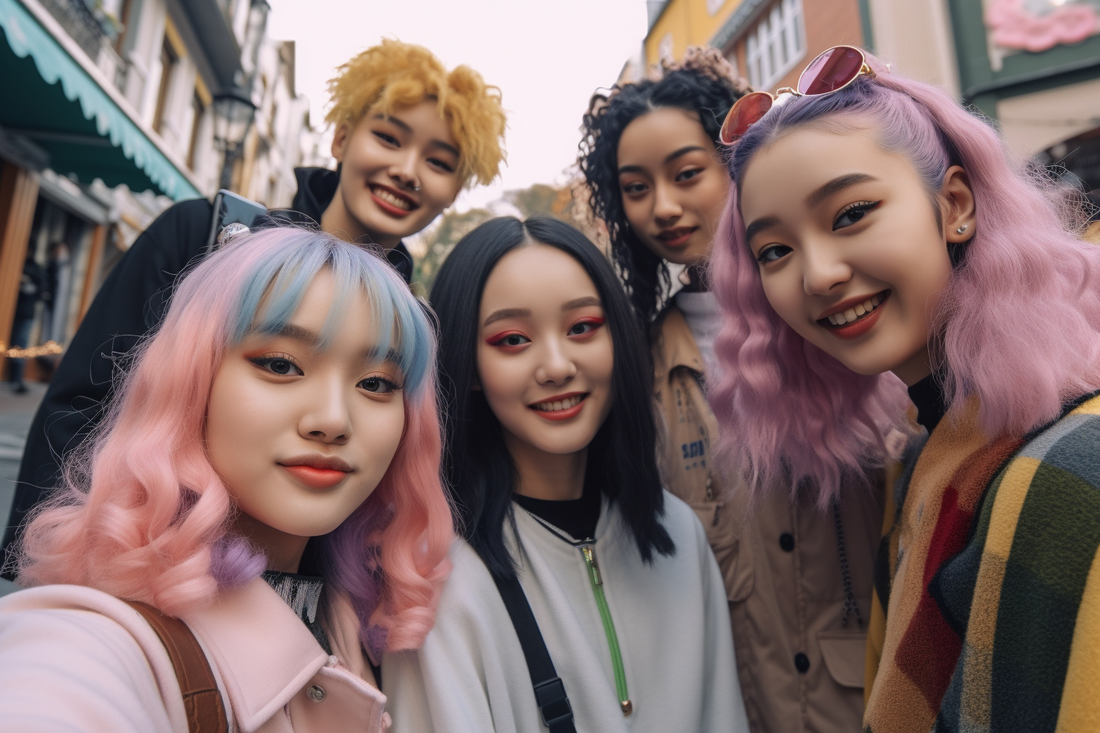
Fascinating Origins of Kawaii Art: The Ultimate Guide to Japan's Cutest Culture
Share
When you think about Japan, what do you imagine? It might be ancient temples, yummy sushi, or busy Tokyo streets. All these are important parts of Japanese culture, but there's something else that has become super popular—kawaii art. Kawaii means "cute" or "lovable" in English, and it's a special, colorful, and fun style that's connected to Japanese pop culture.
You can find kawaii art in many things in Japan, like fashion, food, ads, and buildings. Its popularity has even spread around the world, and you can find fans of kawaii culture everywhere. But what makes kawaii art so special? To understand why people love it so much, we need to learn about its beginnings and history.
In this ultimate guide, we'll discover the exciting start of kawaii art, how it changed over time, and how it has affected cultures worldwide. We'll also share some ideas on how you can add kawaii art to your daily life. So let's jump into the amazing world of Japan's cutest culture!

Kawaii style fashion has always been popular in Japan.
Kawaii History: Where It All Started
The idea of kawaii started a long time ago in Japan's Heian period (794-1185). Back then, important people would give each other small, pretty things called tesaguri. These items had detailed patterns and designs, and they showed a kind of beauty that would later become kawaii style. But kawaii art as we know it today didn't start until the 1900s.
In the 1910s and 1920s, young Japanese women working in factories created a new way of writing called maru-moji (round writing). This cute handwriting had round letters and fun drawings, but older people didn't like it. Even though some people didn't approve, this new writing helped create the kawaii culture we know today.
In the 1960s, kawaii characters started to appear. Japanese artists and designers made new, cute styles because young people loved them. When Hello Kitty was introduced in 1974, kawaii art became even more popular. With her simple, cute design and big eyes, Hello Kitty showed what kawaii was all about and became famous in Japan and other countries.
How Kawaii Art and Design Changed Over Time
Kawaii art has changed a lot over the years and now has many different styles. You can see this in the different kawaii characters that have been created. From simple characters like Hello Kitty and My Melody, kawaii art now includes more detailed characters, like the cool, gothic Gloomy Bear and the fairy tale-inspired Little Twin Stars.
Kawaii art also changed fashion. In the 1990s, kawaii fashion styles like Lolita, fairy kei, and decora became popular. These styles use soft colors, frills, and bows to show kawaii culture.
Kawaii art is also in food and home decorations. You can find bento boxes with cute kawaii characters and cafes with kawaii themes all over Japan. Kawaii home stuff, like bedding and kitchen things, is also popular, so fans can have kawaii stuff everywhere.
Important Parts of Kawaii Art and Design
Even though there are many styles and types of kawaii art, some things are always the same. These include:
- Simplicity: Kawaii art is easy to understand because it has simple designs. This makes it fun for people of all ages and backgrounds.
- Roundness: Kawaii art has lots of round shapes, like big, round eyes and chubby cheeks. Round shapes look soft and innocent.
- Pastel colors: Soft, pastel colors are important in kawaii art because they make things feel warm and cozy. These colors are used in kawaii fashion and in designing kawaii characters and products.
- Whimsical themes: Kawaii art often includes fantasy themes, like fairy tales, magical creatures, and outer space. This makes it feel like an escape into a world of cuteness and wonder.
- Focus on cuteness: Above everything else, kawaii art tries to be as cute and adorable as possible. This is done with sweet characters, playful patterns, and charming details.
Kawaii Characters: Famous Faces of Japanese Pop Culture
Kawaii characters are a big part of kawaii culture, and they help people understand what kawaii art is all about. Some famous kawaii characters include:
- Hello Kitty: Probably the most famous kawaii character, Hello Kitty is a white cat with a red bow and no mouth. Created by Sanrio in 1974, she has become popular around the world and appears on all kinds of things, like stationery and clothes.
- Pokémon: This popular game, which started in 1996, has lots of cute and lovable creatures, like Pikachu, Jigglypuff, and Squirtle. Pokémon is loved by many people and has had TV shows, movies, and trading cards made about it.
- Rilakkuma: Rilakkuma is a lazy, cuddly bear character made by San-X in 2003. He likes to relax with his friends, Korilakkuma and Kiiroitori, and shows the kawaii idea of taking it easy and enjoying life.
- Totoro: Totoro is the star of the famous Studio Ghibli movie "My Neighbor Totoro." This friendly, forest creature has become a symbol of the magic and wonder found in kawaii art.
Kawaii Art in TV, Movies, and Music
Kawaii art isn't just in fashion and design—it's also in TV, movies, and music. Japanese manga and anime are known for their kawaii characters and stories, with big-eyed, cute heroes and fun adventures. This style has influenced people around the world, and now there are Western cartoons and comics that look like kawaii art.
Kawaii art is also in music, like J-pop and K-pop groups such as Kyary Pamyu Pamyu and Blackpink. These musicians use kawaii fashion and themes in their music videos and performances, making kawaii culture even more popular.
Kawaii Culture Around the World
Kawaii art and culture aren't just popular in Japan—people all over the world love it, too. You can find kawaii things, like stationery, clothes, and accessories, in stores and online shops everywhere. There are also events, like conventions and meetups, where fans can celebrate their love for kawaii culture together.
Kawaii art has inspired artists and designers from different countries to make their own cute characters and products. This shows that kawaii art is loved by people everywhere. You can see how popular kawaii culture is by looking at successful non-Japanese kawaii characters, like the Korean Line Friends and the American brand, Tokidoki.
How to Add Kawaii Art to Your Life
If you like kawaii art and want to make your life cuter, here are some ideas:
- Accessorize: Make your clothes cuter with kawaii accessories, like bags, shoes, and jewelry that have your favorite kawaii characters and designs.
- Decorate: Make your home cuter with kawaii things, like bedding, wall art, and kawaii kitchen stuff.
- Be creative: Try making your own kawaii crafts, like plushies, crochets, amigurumi dolls, keychains, or jewelry.
- Socialize: Join online kawaii communities and go to local events to meet other fans and share your love of kawaii art.
- Shop: Support kawaii artists and designers by buying their products and artwork.
Conclusion: Kawaii Art and Culture Are Here To Stay
Kawaii art has come a long way since it started with the handwriting of young factory workers. People all over the world love it because it makes them feel happy, comfortable, and amazed. Kawaii art can be understood and enjoyed by people from many different cultures and languages. As long as there are people who love cuteness, kawaii art and culture will keep making people smile and feel good all around the world!
References:
- Kinsella, S. (1995). Cuties in Japan. In: Lise Skov and Brian Moeran, eds. Women, Media and Consumption in Japan. Honolulu: University of Hawai'i Press, pp. 220-254.
- Yano, C. (2009). Pink Globalization: Hello Kitty's Trek Across the Pacific. Durham, NC: Duke University Press.
- Okazaki, M. (2008). Kawaii!: Japan's Culture of Cute. New York: Prestel.
- McVeigh, B. (2000). How Hello Kitty Commodifies the Cute, Cool, and Camp. Journal of Material Culture, 5(2), pp. 225-245.
- Monden, M. (2015). Japanese Fashion Cultures: Dress and Gender in Contemporary Japan. London: Bloomsbury Academic.
- Ashcraft, B., and Galbraith, P. (2014). Kawaii Japan. Tokyo: Tuttle Publishing.

